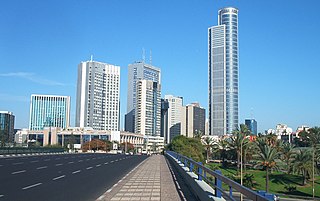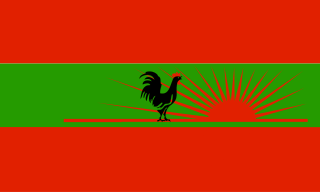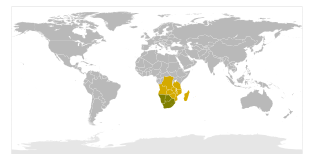
The economy of Angola remains heavily influenced by the effects of four decades of conflict in the last part of the 20th century, the war for independence from Portugal (1961–75) and the subsequent civil war (1975–2002). Despite extensive oil and gas resources, diamonds, hydroelectric potential, and rich agricultural land, Angola remains poor, and a third of the population relies on subsistence agriculture. Since 2002, when the 27-year civil war ended, government policy prioritized the repair and improvement of infrastructure and strengthening of political and social institutions. During the first decade of the 21st century, Angola's economy was one of the fastest-growing in the world, with reported annual average GDP growth of 11.1 percent from 2001 to 2010. High international oil prices and rising oil production contributed to strong economic growth, although with high inequality, at that time.

Blood diamonds are diamonds mined in a war zone and sold to finance an insurgency, an invading army's war efforts, terrorism, or a warlord's activity. The term is used to highlight the negative consequences of the diamond trade in certain areas, or to label an individual diamond as having come from such an area. Diamonds mined during the 20th–21st century civil wars in Angola, Ivory Coast, Sierra Leone, Liberia, Guinea, and Guinea-Bissau have been given the label. The term conflict resource refers to analogous situations involving other natural resources. Blood diamonds can also be smuggled by organized crime syndicates so that they could be sold on the black market.

The Kimberley Process Certification Scheme (KPCS) is the process established in 2003 to prevent "conflict diamonds" from entering the mainstream rough diamond market by United Nations General Assembly Resolution 55/56 following recommendations in the Fowler Report. The process was set up "to ensure that diamond purchases were not financing violence by rebel movements and their allies seeking to undermine legitimate governments".
The World Diamond Council is an organization representing the entire diamond value chain including representatives from diamond mining, manufacturing, trading and retail. The council was established in July 2000. The purpose was to create a system to keep the supply chain of diamonds as free as possible from conflict diamonds.
The Diamond Trading Company (DTC) is the rough diamond sales and distribution arm of the De Beers Family of Companies. The DTC sorts, values and sells about 35% of the world’s rough diamonds by value. The DTC has a combination of wholly owned and joint venture operations in South Africa (DTCSA), Botswana (DTCB), Namibia (NDTC) and the United Kingdom (DTC).

Global Witness is an international NGO established in 1993 that works to break the links between natural resource exploitation, conflict, poverty, corruption, and human rights abuses worldwide. The organisation has offices in London and Washington, D.C.
The US-Morocco Free Trade Agreement is a bilateral trade agreement between the United States and Morocco. The agreement was signed on June 15, 2004, followed by U.S. President George W. Bush's signing of the USMFTA Implementation Act on August 17, 2004. The United States House of Representatives ratified the pact on July 22, 2004 by a 323–99 vote. The United States Senate passed the bill by unanimous consent on July 21, 2004. The Morocco FTA came into effect on January 1, 2006.

The Diamond industry of Israel is an important world player in producing cut diamonds for wholesale. In 2010, Israel became the chair of the Kimberley Process Certification Scheme. As of 2016, cut diamonds constituted 23.2% of Israel's total exports and they were the country's biggest export product, amounting to 12% of the world's production.

Angola and the United States have maintained cordial diplomatic relations since 1993. Before then, antagonism between the countries hinged on Cold War geopolitics, which led the U.S. to support anti-government rebels during the protracted Angolan Civil War.
Lazare Kaplan International Inc. (LKI) is a diamond manufacturing and distribution company based in New York City. The Chairman of the Board of Directors is Maurice Tempelsman. The first LKI was located in Ponce, Puerto Rico, at el Barrio de los Diamantes, a community named after the factory was located there. LKI was founded in 1903 where it operated until it was moved to Caguas, Puerto Rico in the 1970s.
The Fowler Report, released on March 14, 2000, is a United Nations report detailing how various companies, African and European governments, including that of Angola and the political wing of UNITA, violated the Lusaka Protocol as well as UN-imposed sanctions. Robert Fowler, Canada's ambassador to the United Nations, headed the commission that compiled the report, which raised widespread international concern by highlighting the strong link between the illicit diamond trade and third world conflicts.

United Nations Security Council resolution 864, adopted unanimously on 15 September 1993, after reaffirming resolutions 696 (1991), 747 (1992), 785 (1992), 793 (1992), 804 (1993), 811 (1993), 823 (1993), 834 (1993) and 851 (1993), the Council noted the continuing situation in Angola and went on to condemn and place international sanctions on UNITA.

United Nations Security Council resolution 1295, adopted unanimously on 18 April 2000, after reaffirming Resolution 864 (1993) and all subsequent resolutions on Angola, particularly resolutions 1127 (1997), 1173 (1998) and 1237 (1999), the Council authorised a tightening of sanctions against UNITA and established a panel of experts to investigation violations of Security Council resolutions imposing measures against UNITA.

United Nations Security Council resolution 1306, adopted on 5 July 2000, after recalling all previous resolutions on the situation in Sierra Leone, particularly resolutions 1132 (1997), 1171 (1998) and 1299 (2000), the Council decided to prohibit the direct or indirect import of rough diamonds from the country. The rebel Revolutionary United Front controlled 90% of the diamond-producing areas in Sierra Leone and was using diamonds to finance its operations.

United Nations Security Council resolution 1459, adopted unanimously on 28 January 2003, after recalling resolutions 1173 (1998), 1295 (2000), 1306 (2000), 1343 (2001), 1385 (2001) and 1408 (2002) concerning the illicit trade in diamonds, the Council expressed support for the Kimberley Process Certification Scheme (KPCS).

United Nations Security Council Resolution 1643, adopted unanimously on 15 December 2005, after recalling previous resolutions on the situation in Côte d'Ivoire, the Council extended an arms embargo and travel and financial restrictions against the country until 15 December 2006, and included a ban on the trade of diamonds.
United Nations Security Council Resolution 1753 was unanimously adopted on 27 April 2007.
United Nations Security Council Resolution 1819 was unanimously adopted on 18 June 2008.
Charmian Penelope Gooch is a British anti-corruption campaigner and activist. She is a co-founder and board member of the NGO Global Witness, where she works to uncover and fight corruption in the developing world.

Eli Izhakoff is an American businessman in the international diamond and jewelry industry, filling a variety of public positions since 1979.












